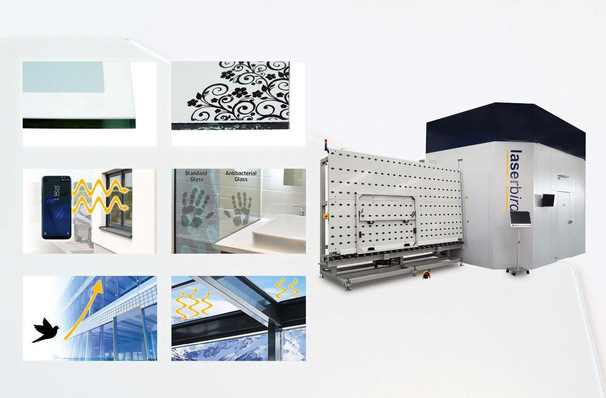Automation is becoming an essential tool to counteract the problem of skills shortages. But is this step also profitable for a relatively small and medium family business? The insulating glass manufacturer SA Michel Deschanet proves, that with courage, flexibility and innovation, it is possible to remain competitive in a rough market.
The fact that it already invested in 2012 in an automatic line for the production of triple insulating glazing with Super Spacer, Pascale Roche-Deschanet has never regretted it. Today, with the ongoing pandemic it is easier to maintain safety distances and to compensate for sickness-related downtime with an automated production. "Thanks to end-to-end automation we can provide optimum protection for our employees, respond flexibly to customer requirements and guarantee on-time delivery," Madame Roche-Deschanet concludes.
Automation ensures competitiveness
Together with her husband Didier Roche, the daughter of the company's founder runs the insulating glass manufacturer SA Michel Deschanet, based in Augny, France. In 2019, they once again invested millions for a second automation step. The high demand towards laminated glass and the significant increase in the number of glass variants lead the company to rationalize storage. "As a family business, we always have to be agile and innovative in order to remain competitive. In 2018, we have developed a concept “full automatic” to optimize our production upstream of the insulating glass lines," explains Roche. From unloading the delivered glass sheets to cutting and storing them in a buffer store to feeding around 100 different glass types to the lines for double and triple glazing, the entire production process at Deschanet is now fully automated. Units with different glass structures and combinations of float glass and laminated glass can now be produced easily. The automated cutting alone has increased the daily volume by 40 %.
Early adopter of triple glazing with Super Spacer warm edge

Deschanet
In addition to production efficiency, quality aspects played a major role in the investment in the first Super Spacer line in 2012. "At Deschanet, we firmly believed that energy-efficient triple glazing would give us a competitive edge," explains the company owner. Indeed, at that time, a large proportion of new windows in northern European countries and also Germany were already triple glazed. In France, on the other hand, double glazing was still booming. The development proved that was Deschanet right. Today, 40 % of the insulating glass units produced in-house are triple-glazed, predominantly with Super Spacer T-Spacer Premium Plus as warm edge spacers.
[Warm edge spacer system for structural glazing and XXL glass panes]
"For demanding structural glazing and facade projects, we get the most out of our production in terms of quality and efficiency," explains Roche. "We were the first French company to process Super Spacer in an automated way. This allowed us to reduce the production process essentially to the three steps of spacer application, joining glass sheets, filling and pressing them with gas, and applying the secondary seal." Above all, the precision with which the spacers can be applied is a quality feature that customers also appreciate, because it shows in the aesthetics of the installed windows, especially the neatly finished edge seal. A tolerance of less than one tenth of a millimeter even for the large panes of 2,500 x 3,500 mm cannot be achieved with manual processing.
Energy efficient glazing for greenhouses and tropical houses
An estimated 900,000 m2 of glazing with Super Spacer have been delivered to date. The very first major order with the flexible warm edge was a lighthouse project in France: 6,000 m2 of cold-bent, high-performance double-glazed insulating glass for a new tropical greenhouse at Vincennes Zoo in Paris. At 100 meters long, 40 meters wide and 16 meters high, the 4,800 m2 glass vault, under which the landscapes of Guyana and Madagascar spread out over 3,000 m2 of planted area in a humid tropical climate, is immensely impressive. The glass panels are extremely translucent to give the plants ideal growing conditions, and the double glazing, in combination with natural ventilation, is designed to support the ambitious energy efficiency targets. Because, of course, keeping such a large glass dome at a constant 20°C to 25°C and 75 % relative humidity is an energy challenge. The glass structure is regularly humidified from a system of nozzles, which can mean a surprisingly damp shower for some visitors. Due to the size of 1.5 x 0.75 meters, the panels could be fitted into the structure on site with an angle of 4° to 5°. Extensive structural calculations as well as tests such as accelerated aging had been performed in advance for ATeX approval.
[Calligraphic windows for the Museum of the Future]
All Deschanet products are CEKAL certified. By focusing on energy-efficient insulating glazing with outstanding thermal performance, Deschanet offers a real differentiator for customers seeking HQE (Haute Qualité Environmentale) certification, BBC (Bâtiment Basse Consommation) qualification, or certification to one of the other standards in use internationally.
Automation makes it faster and better!

Deschanet
"The company Deschanet is a prime example of how automation can increase production capacity while producing high-quality insulating glass much faster and more profitably," said Fabrice Keller, Area Manager for France at Edgetech Europe GmbH. "The smooth integration of the application robot for Super Spacer is a key aspect of this. No matter what window format or glass structure, the line can operate without interruption thanks to the sophisticated componant logistics."
Speed was also required for their second major greenhouse project, which Deschanet completed in 2017. Facade contractor Mtechbuild had won the contract to build five dome-shaped greenhouses. Mtechbuild supplied the steel structure, and Deschanet produced 15,000 m2 of toughened glass mounted in double glazing, which were cold bent on site, within two and a half months. "The project was a very special challenge, as five glass domes, one of them larger than the dome of the Reichstag building in Berlin, had to be manufactured, transported by ship to Vietnam and fully assembled in 6 months," explains Franck Champaign, head of Mtechbuild.
The greenhouses are a central part of the "World Garden" in the Vin Pearl theme park in Nha Trang and each symbolizes a different climate zone. The largest has a diameter of 52 m and is home to cacti, while the other four are 36 m in diameter. Most of the climate control is provided by natural ventilation and textile solar shading, supported by the double glazing with the energy-efficient Warm Edge spacers. The structure of the glass half-domes resembles an orange peel with gaps tapering towards the top and meant a special challenge for Deschanet: in order to follow the shape of the dome exactly, triangular and trapezoidal glasses were manufactured in addition to the basic 1.60 x 1 m glasses for the exact fit. The entire glass structure with Super Spacer, a secondary seal made of silicone and a special tempering glass coating was tested in advance for suitability for cold bending to ensure the tightness of the edge seal even under tension.













